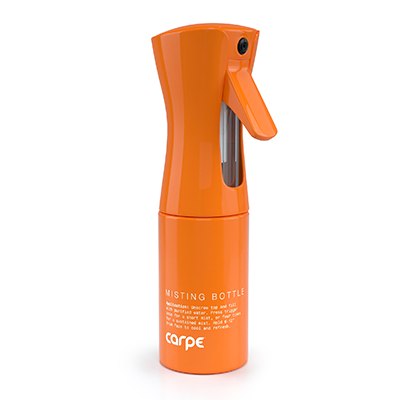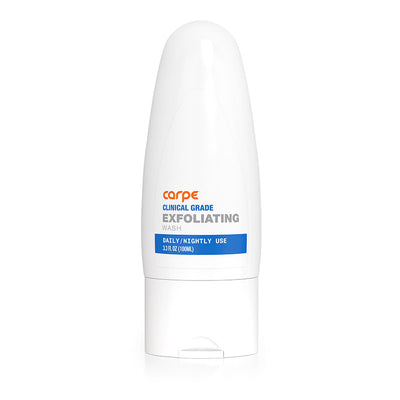Anyone can struggle with excessive facial sweating under the right conditions, but some people struggle more than others. People who consistently deal with sweating of the face and head may be suffering from a condition called craniofacial hyperhidrosis. It is a type of primary focal hyperhidrosis that causes patients to sweat excessively from the forehead, scalp, nose, chin, and sometimes, cheeks. About 3% of the population has some type of primary focal hyperhidrosis, but only 22.8% of those with the condition specifically have craniofacial sweating.[1] If you think you may have craniofacial hyperhidrosis, or you just struggle with facial sweating, check out these treatment options that may help you find some relief.
Antiperspirants
The first-line treatment for hyperhidrosis in general are over-the-counter topical treatments called antiperspirant. Antiperspirants are agents that reduce the body’s production of sweat and they are usually applied to the skin. Most antiperspirants use aluminum chloride or another type of metallic salt as an active ingredient. Unfortunately, these ingredients can be irritating to the skin which makes it hard to choose the right over-the-counter antiperspirant, especially for those with facial sweating.[2] There are some antiperspirants that are made specifically for the sensitive skin on areas like the face and groin. One brand, called Neat Feat 3B Face Saver Antiperspirant Gel for Facial Perspiration and Shine, is available on Amazon and is specifically formulated for facial sweating. Another brand, called Carpe, will be coming out with an antiperspirant specifically formulated for facial use in May of 2019, which is just a few months away. These new facial antiperspirants will give people selection that was not available until quite recently. Antiperspirants can be safely used on the face, but you should be careful about which products you use as irritation can become an issue. If you find that over-the-counter antiperspirant is not enough, there are some prescription options you can discuss with your dermatologist.
Oral Medications
Sometimes, oral medications are used to treat hyperhidrosis. Most often, doctors will prescribe a type of medication called an anticholinergic which causes the body to produce less sweat by interfering with a neurotransmitter called acetylcholine.[1] Anticholinergics can be effective for some people, but they often have burdensome systemic side effects because they affect the entire body. Glycopyrrolate and oxybutynin are the most common anticholinergics prescribed for hyperhidrosis.[2] Anticholinergics are sometimes available in a topical form that can be applied directly to skin with less side effects, but these medications are newer in the treatment of hyperhidrosis.[3]
Botox
Botox, or botulinum toxin A, has been used to treat hyperhidrosis successfully and is FDA approved for the treatment of axillary hyperhidrosis. It has also been a useful treatment for people with excessive facial sweating when more conservative options haven’t worked. Botox is a toxin made by the bacteria Clostridium botulinum and injected into the skin to stop sweat from being produced.[3] While it is effective, botox does come with some risks when used on the face. Specifically, facial asymmetry is an issue as one side of the face may droop after treatment (ptosis).[4] More studies need to be done to demonstrate how safe and effective botox is for facial sweating, but it is a promising treatment option.
Endoscopic Thoracic Sympathectomy
Endoscopic thoracic sympathectomy (ETS) is a type of surgical procedure used to treat primary focal hyperhidrosis. It is typically used to treat palmar hyperhidrosis (sweaty hands) and it is sometimes used to treat axillary hyperhidrosis. However, ETS is an invasive surgery and it comes with some big risks. Patients can develop complications, like compensatory sweating, that can occasionally be worse than the original hyperhidrosis. Therefore, ETS should only be considered when all other treatment options have been exhausted. The surgery works by disconnecting the nerves that communicate with sweat glands so that they cannot tell them to produce sweat anymore.[3] In order for the surgery to stop craniofacial sweating a surgeon would have to operate on the T2 or T3 area of the spine, which is quite high up on the spine for this type of surgery. It is not commonly done, but it can be very effective when performed by a skilled surgeon.
If you struggle with excessive facial sweating, keep looking until you find a treatment that works for you. There are new innovations happening every day as the medical field recognizes hyperhidrosis as a common and treatable condition more and more each day.
Sources
- Nicholas, R., Quddus, A., & Baker, D. M. (2015). Treatment of Primary Craniofacial Hyperhidrosis: A Systematic Review. American Journal of Clinical Dermatology, 16(5), 361-370. doi:10.1007/s40257-015-0136-6
- Pariser, D. M. (2014). Hyperhidrosis (4th ed., Vol. 32). Philadelphia, PA: Elsevier.
- Craniofacial hyperhidrosis can usually be managed pharmacologically, but surgery may sometimes be needed. (2016). . Drugs & Therapy Perspectives, 32(5), 191-194. doi:10.1007/s40267-016-0282-9
- Huddle, J. R. (2014). Hyperhidrosis: Causes, Treatment Options and Outcomes. New York, NY: Nova Science.






16790753702383.jpg?v=1679075372)

16790746985853.jpg?v=1679074700)


16790757289763.jpg?v=1679075731)









